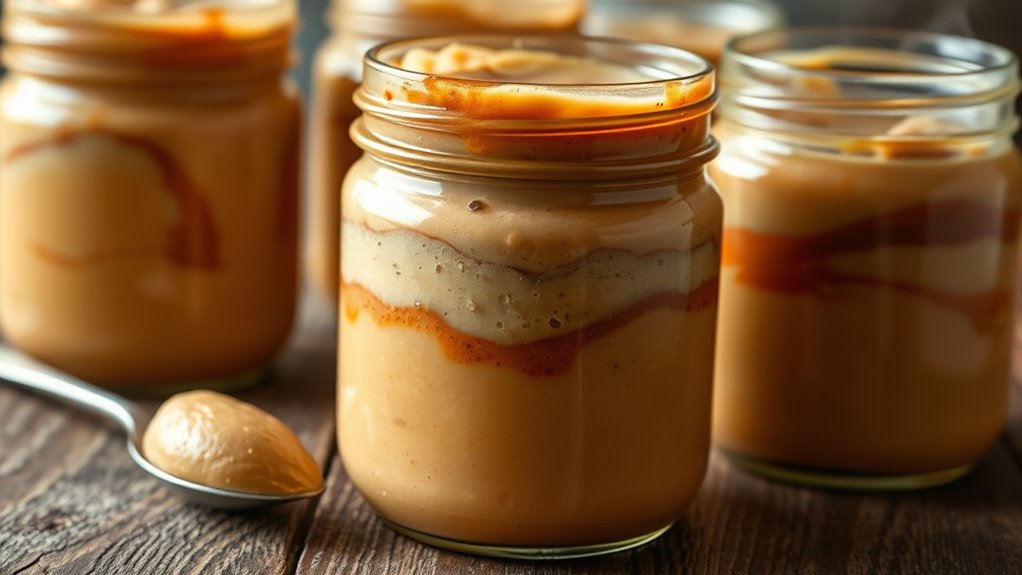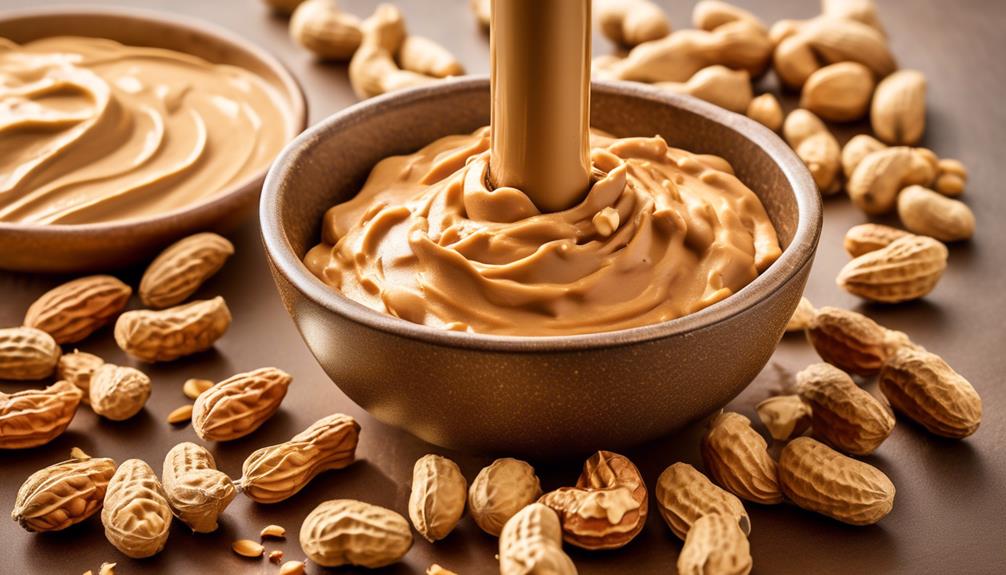Peanut butter fermentation is an emerging trend that offers unique flavors, improved nutrition, and potential probiotic benefits, but it also comes with safety challenges. You might enjoy its complex taste and texture changes, yet must handle risks like contamination and allergen exposure carefully. The trend’s success depends on proper fermentation techniques and safety measures. If you want to explore whether this innovative process is worth trying, there’s more to discover below.
Key Takeaways
- Fermented peanut butter offers unique flavors and potential health benefits, making it an innovative culinary trend.
- Proper fermentation controls are essential to prevent contamination and ensure safety, posing some challenges.
- Microbial activity enhances nutrient bioavailability and probiotic qualities, supporting gut health.
- Risks include allergen exposure and difficulty maintaining optimal fermentation conditions.
- The trend’s success depends on consumer acceptance, safety practices, and industrial scalability.
The Science Behind Fermenting Peanut Butter
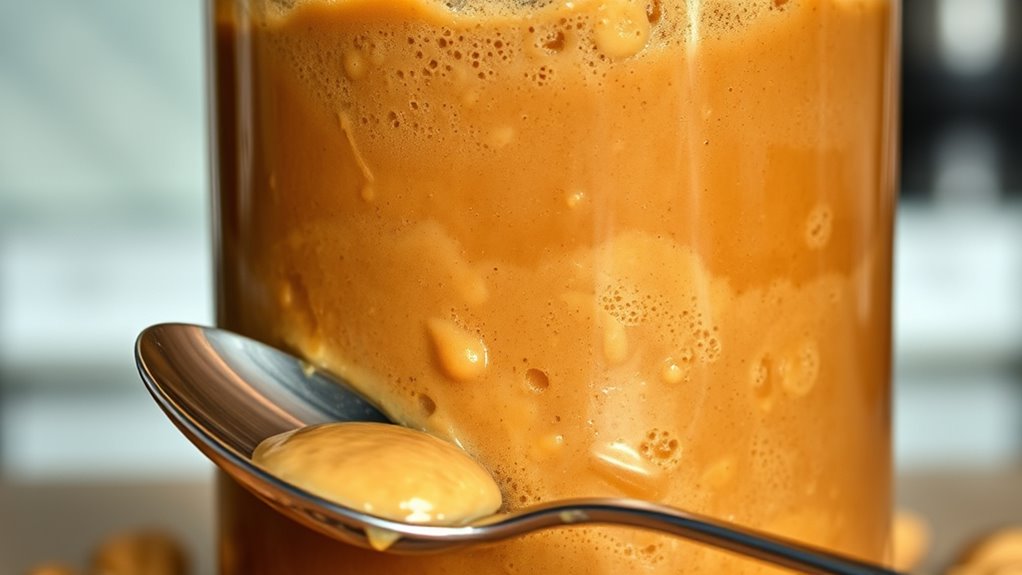
Fermenting peanut butter relies on the activity of beneficial microbes that break down natural sugars and proteins in the peanuts. This process depends on microbial diversity, which influences the flavor and safety of the final product. Ensuring fermentation safety is vital; introducing the right microbes prevents harmful bacteria from thriving. When you ferment peanut butter, you create an environment where specific lactic acid bacteria or yeasts outcompete undesirable microbes. This microbial activity produces acids and other compounds that inhibit spoilage and pathogens. Maintaining proper temperature, hygiene, and fermentation time helps control the microbial landscape, ensuring a safe and successful fermentation. Understanding the science behind these microbial interactions allows you to craft flavorful, safe fermented peanut butter confidently. Incorporating practical tools and evidence-based strategies can help you cut through the noise of misinformation and achieve a successful fermentation process.
Potential Health Benefits and Nutritional Gains

By fermenting peanut butter, you not only develop unique flavors but also reveal potential health benefits and enhance its nutritional profile. The fermentation process promotes nutritional enhancement by increasing bioavailability of nutrients like amino acids, vitamins, and minerals. It can also boost probiotic potential, introducing beneficial bacteria that support gut health. These probiotics may improve digestion, strengthen immunity, and reduce inflammation. Additionally, fermentation can decrease antinutrients and natural toxins in peanuts, making nutrients more accessible. Color accuracy and contrast ratios are key factors that influence the visual quality of projectors, ensuring vibrant and detailed images. As a result, your fermented peanut butter could offer more than just taste—it might contribute to overall well-being. While research is ongoing, this method holds promise for turning a familiar snack into a functional food with added health advantages.
Flavor Profiles and Texture Transformations
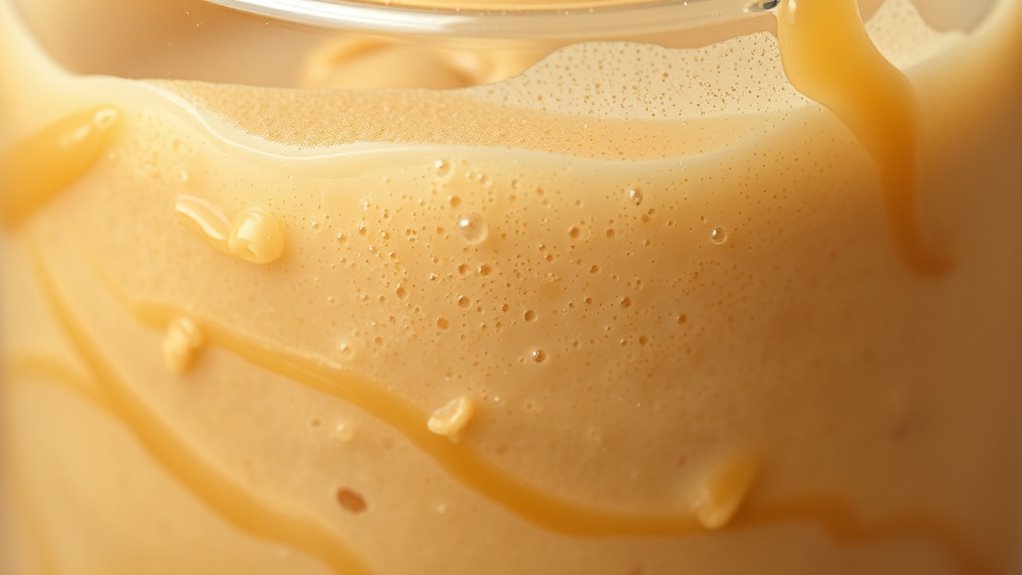
As fermentation progresses, the flavor profile of peanut butter undergoes remarkable changes, developing complex, tangy, and sometimes nutty notes that differ markedly from its original taste. You might notice unexpected yet appealing innovative flavor combinations that emerge, adding depth and intrigue to your creation. The fermentation process also leads to significant textural innovation, transforming the smooth, creamy consistency into a more nuanced, sometimes crumbly or gooey state. These changes can enhance the sensory experience, offering new ways to enjoy familiar flavors. Depending on the fermentation stage, you might find your peanut butter developing a richer, more layered taste and a unique mouthfeel. Additionally, understanding the personal development principles behind experimentation can boost your confidence to explore these culinary transformations. Overall, fermentation opens the door to exciting flavor and texture transformations that challenge traditional expectations.
Risks and Challenges of Peanut Butter Fermentation
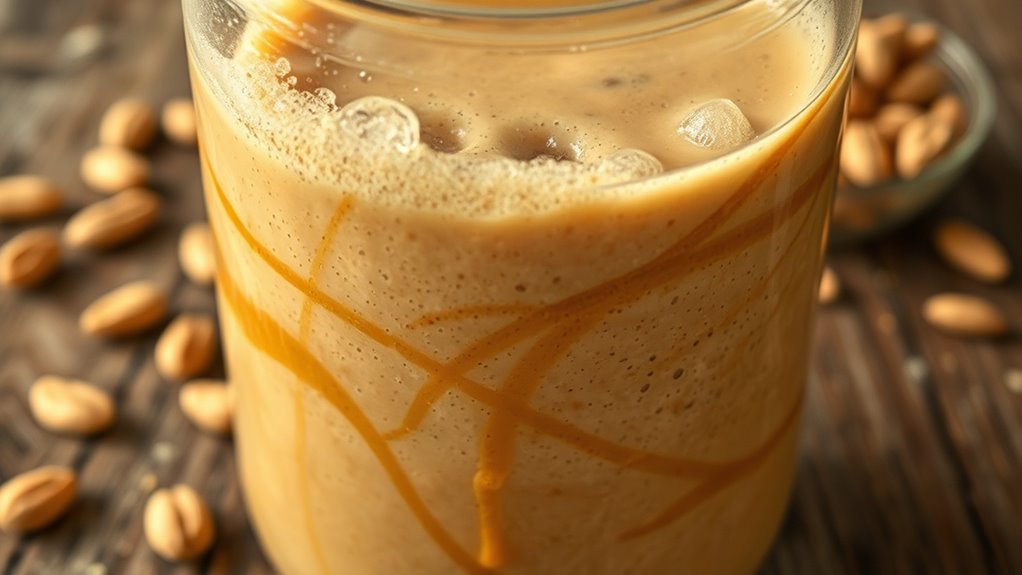
While peanut butter fermentation offers exciting flavor and texture changes, it also presents several risks and challenges that you need to manage carefully. First, allergy risks are significant; peanuts are common allergens, and fermentation may increase allergen exposure or cross-contact. Second, contamination concerns arise because improper handling can introduce harmful bacteria or mold, risking foodborne illnesses. Third, fermentation control is tricky—if you don’t monitor conditions like temperature and pH closely, the process can produce undesirable or unsafe results. Ensuring cleanliness, using high-quality ingredients, and understanding fermentation science are essential. Proper storage recommendations from food safety guidelines are critical to prevent spoilage and ensure product safety. Failure to address these risks can lead to health issues or product spoilage, making it vital to approach peanut butter fermentation with caution and proper knowledge.
Is This Trend Worth Trying? Evaluating Its Future

Deciding whether peanut butter fermentation is worth trying depends on your willingness to experiment and manage its inherent risks. Cultural acceptance plays a significant role; while some food enthusiasts embrace innovative flavors, others may be hesitant to try fermented peanut butter. If you’re open to new culinary experiences, this trend could offer unique taste profiles and health benefits. However, for it to gain widespread popularity, industrial scalability must be addressed. Large-scale production requires consistent quality control and safety measures, which currently pose challenges. Despite these hurdles, the potential for mainstream adoption exists if producers can navigate these barriers. Ultimately, whether you pursue this trend depends on your interest in culinary exploration and confidence in its long-term viability in the market. Additionally, understanding food safety protocols is crucial when experimenting with fermented products to ensure consumer health is protected.
Frequently Asked Questions
How Long Does the Fermentation Process Typically Take?
You might wonder how long fermentation takes, and it varies based on your desired flavor and texture. Typically, fermentation duration ranges from a few hours to several days. Timing considerations include temperature and humidity, which influence the process. Keep an eye on the peanut butter during fermentation, tasting periodically to achieve your ideal flavor. Longer fermentation can deepen flavor, but overdoing it might lead to undesirable results.
Can Any Type of Peanut Butter Be Fermented?
Imagine spreading creamy peanut butter on toast, its texture smooth and inviting. When you ferment peanut butter, you can use most types, but the texture might change, becoming chunkier or more liquid. Different peanut butters, like natural or processed, respond uniquely, leading to flavor modifications that range from tangy to complex. So, yes, you can ferment any type, but be prepared for varied textures and taste twists in your culinary adventure.
What Are the Best Storage Methods Post-Fermentation?
After fermentation, you should store your peanut butter in airtight storage containers to prevent contamination and preserve flavor. Refrigeration techniques are essential; keep it in a cool, consistent temperature to slow spoilage. Make sure the container seals tightly, and avoid leaving it at room temperature for extended periods. Proper storage helps maintain the unique flavors developed during fermentation and guarantees your peanut butter stays fresh and safe to enjoy.
Are There Specific Strains of Bacteria Used in Peanut Butter Fermentation?
Imagine you’re a microbiologist in a sci-fi movie—specific strains of bacteria revolutionize peanut butter fermentation. You’ll find that Lactobacillus and Bifidobacterium are commonly used, promoting microbial diversity and ensuring fermentation safety. These strains help develop unique flavors while preventing harmful bacteria growth. By selecting the right microbes, you control the process, minimize risks, and create a delicious, safe product that delights your taste buds and satisfies food safety standards.
How Does Fermentation Affect Allergen Levels in Peanut Butter?
Fermentation can alter allergenic proteins in peanut butter, potentially reducing allergenicity and making it safer for some consumers. However, it also involves microbial activity, so you need to guarantee proper fermentation processes to maintain microbial safety. By breaking down allergenic proteins, fermentation might lower allergy risks, but inconsistent results could pose safety concerns. Always choose fermented peanut butter from reputable sources that prioritize both allergen reduction and microbial safety.
Conclusion
Think of peanut butter fermentation as a wild ride on a flavor rollercoaster—exciting but unpredictable. While it offers intriguing health perks and unique tastes, it’s not without risks. If you’re daring enough to explore the unknown, proceed with caution and curiosity. Embrace the adventure, but remember, not every twist leads to a sweet ending. Ultimately, whether you hop on or stay safe, this trend’s future hangs in your hands—ready to take the plunge?
